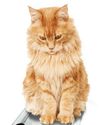
Based on that line of thinking, you would think that a male cat with an enlarged prostate gland would be a lean, mean, super-stud able to impregnate females with a single glance.
Unfortunately, it is more likely to result in a transfer to premiership.
I learned this from personal experience after running into repeated blockage and bloody urine episodes with an otherwise healthy young male who had just bred his first girl. If these symptoms occur in a breeding male, there may be a different problem than the more common issues of urinary crystals, stones or inflammatory plugs, and you may very well end up at the emergency vet, just as I did.
After my cat had been examined and tested, the vet told me that the X-rays showed an enlarged prostate. She recommended an emergency neuter, because the prostate had increased in size so it was pinching the poor boy’s urethra. However, first the cat had to be stabilized for any surgery.
Understanding the Role of the Prostate
Although it is not involved in sperm production, the prostate gland is essential to successful breeding because it provides the major part of the fluid in the ejaculate and is important in nourishing the sperm cells and increasing their movement.1 This gland is located within the pelvis and behind the bladder,1 on the top and sides of the urethra, the tube that carries urine from the bladder to the outside of the body. Because the urethra travels under the prostate after leaving the bladder, an enlarged prostate can impact the urine flow.
This story is from the October 2023 edition of Cat Talk.
Start your 7-day Magzter GOLD free trial to access thousands of curated premium stories, and 9,000+ magazines and newspapers.
Already a subscriber ? Sign In
This story is from the October 2023 edition of Cat Talk.
Start your 7-day Magzter GOLD free trial to access thousands of curated premium stories, and 9,000+ magazines and newspapers.
Already a subscriber? Sign In

Life With Patrick
Patrick and Mount Doom

Feline Photographers Part 1
\"Cats never strike a pose that isn't photogenic.\" - Lillian Jackson Braun

The Cat Fancy Alphabet
\"The Cat Fancy Alphabet\" is a new feature in Cat Talk. It highlights various terms and aspects of the cat fancy, educating fanciers new and old about our hobby.

UP CLOSE AND Purr-sonal
If there is one person, or even just a name, that anyone in CFA (Cat Fancier Association) knows, it would have to be Allene Tartaglia. It might be from her involvement with most aspects of the operations of CFA in her position of executive director. Or perhaps from her deep involvement with both the CFA Annual meeting and/or the International Show. Cat Talk thought it was time to learn more about one of the most key people in CFA.

Vision and Hearing Dysfunctions in Senior Cats
Just as people are challenged by having deficiencies with vision and hearing over time, so are senior cats. In senior cats, pet owners may notice their cats are no longer responding to them in the same way; however, it may be difficult to figure out.

Senior Cats and House Soiling
Why is my cat no longer using its litter box? Cat soiling in the house is one of the most talked about issues for pet owners.

Nutrition for Our Senior Cats
From the time they are born, our kittens receive a tremendous amount of care, with diet being at the core of their growth and development.

Fluffy's Sixteen and STILL Plays Like a Kitten!
Enrichment for Senior Cats

Alternative Arthritis Treatments for Cats
Just like humans, cats can experience arthritis. About 90% of cats over the age of 10 years experience osteoarthritis (OA) in at least one joint.1 It is a complex condition involving inflammation and degeneration of one or more joints and is sometimes referred to as degenerative joint disease (DJD). Cats with OA experience pain and inflammation in various joints that interfere with daily activities.

Checklist For What to Look For in Your Club's Next Show Venue
Show Manager To Ring One, Please